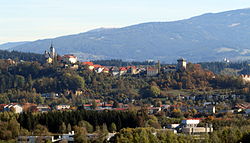Althofen | |
|---|---|
 Stadt Althofen im September 2013 | |
| Coordinates: 46°52′N14°28′E / 46.867°N 14.467°E | |
| Country | Austria |
| State | Carinthia |
| District | Sankt Veit an der Glan |
| Government | |
| • Mayor | Dr. Walter Zemrosser |
| Area | |
• Total | 12.29 km2 (4.75 sq mi) |
| Elevation | 714 m (2,343 ft) |
| Population (2018-01-01) [2] | |
• Total | 4,759 |
| • Density | 390/km2 (1,000/sq mi) |
| Time zone | UTC+1 (CET) |
| • Summer (DST) | UTC+2 (CEST) |
| Postal code | 9330 |
| Area code | 04262 |
| Website | althofen.gv.at |
Althofen (Slovene : Stari Dvor) is a town in the district of Sankt Veit an der Glan in the Austrian state of Carinthia.





